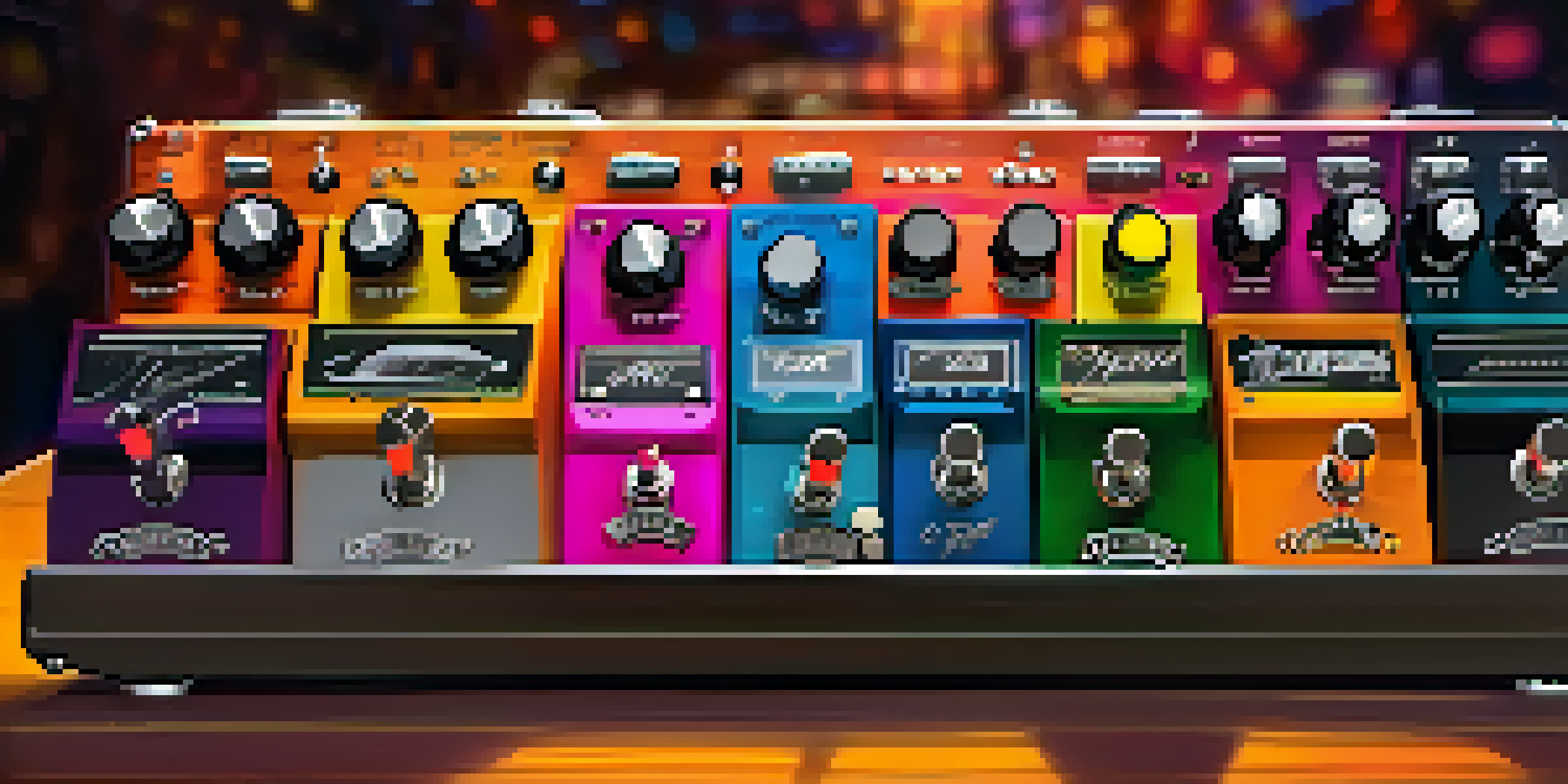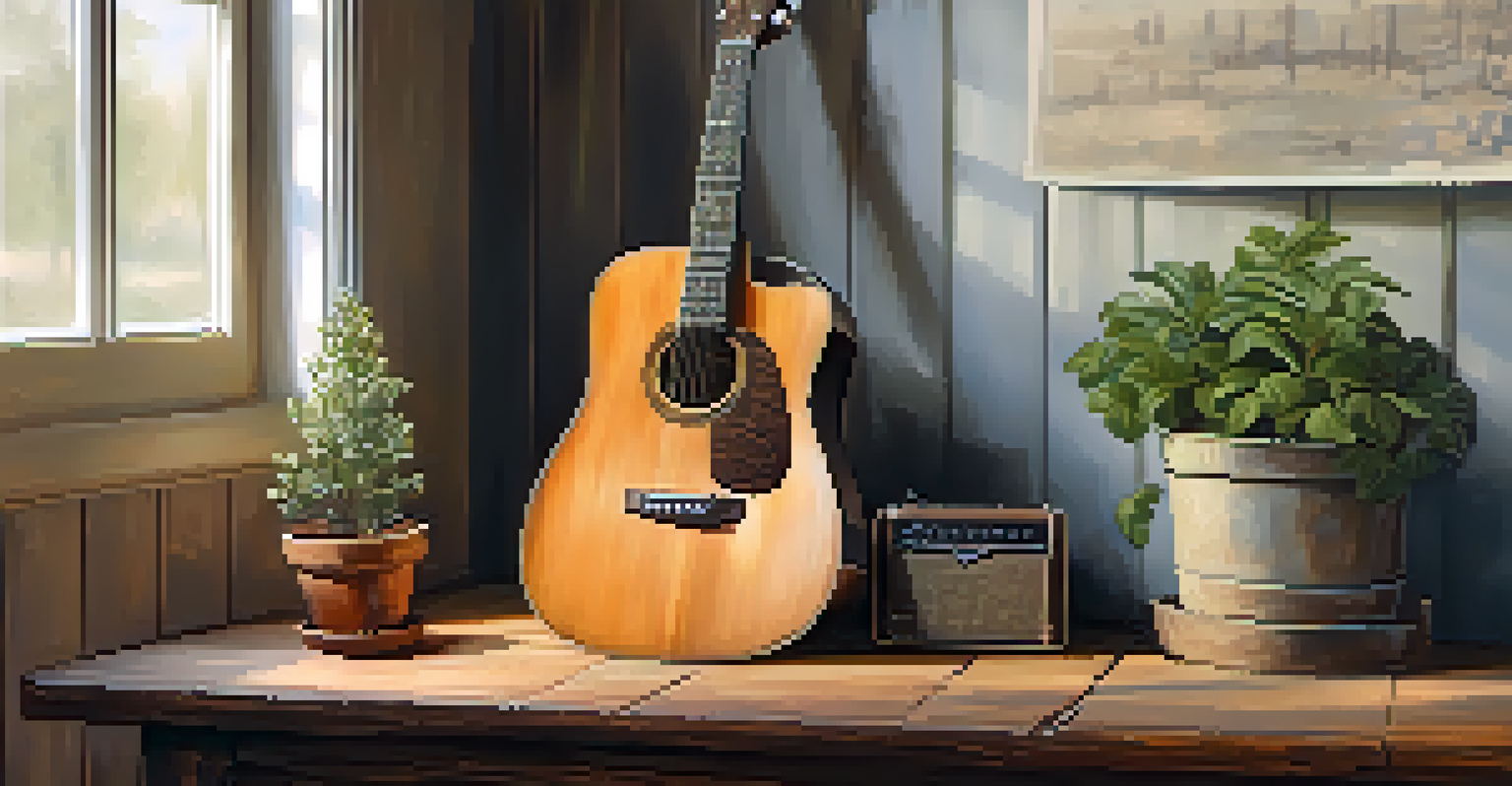Using Effects: How Pedals Enhance Emotional Guitar Tone

Understanding Guitar Pedals and Their Functionality
Guitar pedals are small devices that modify the sound of your guitar, allowing you to shape your tone creatively. They work by altering the signal from your guitar before it reaches your amplifier. This process can add various effects, such as distortion, delay, or reverb, each contributing to the emotional depth of your music.
Music is the shorthand of emotion.
Imagine your guitar tone as a blank canvas; pedals are the colors that bring your artwork to life. Each pedal type serves a different purpose, whether you're looking to add a touch of warmth or a sense of space. By experimenting with different combinations, you can find the perfect palette for your unique sound.
Understanding how each pedal interacts with your guitar and amp is crucial. For instance, a distortion pedal can make your playing feel raw and aggressive, while a chorus pedal adds a lush, dreamy quality. This knowledge empowers you to express your emotions more effectively through your music.
The Emotional Impact of Distortion Pedals
Distortion pedals are often associated with rock and metal genres, known for their gritty and powerful sound. When you crank up the gain, the resulting growl can evoke feelings of rebellion and intensity. It's like pouring gasoline on a fire; it ignites passion and energy in your performance.

But distortion isn't limited to heavy music. Artists across various genres use it to convey a sense of urgency or angst. For example, think of a blues guitarist using a light overdrive to express sorrow; the subtle growl adds depth to their emotional storytelling.
Guitar Pedals Shape Your Sound
Guitar pedals modify your guitar's signal, allowing for creative tone shaping and emotional expression in your music.
Ultimately, distortion pedals can enhance your music by allowing you to tap into raw emotions. Whether you're aiming for a hard-hitting riff or a heartfelt solo, the right level of distortion can significantly amplify your message and connect with your audience.
Creating Atmosphere with Reverb and Delay
Reverb and delay pedals are essential for creating a sense of space in your sound. Reverb simulates the natural echoes you hear in different environments, from a small room to a grand cathedral. This effect can transform a simple note into a lush, atmospheric experience, making the listener feel enveloped in your music.
The beautiful thing about learning is that no one can take it away from you.
Delay pedals, on the other hand, repeat your notes after a set time, adding depth and complexity to your playing. This layering can create a hypnotic effect, drawing listeners into the emotional landscape of your performance. Imagine a haunting melody that lingers in the air, leaving a lasting impression.
Together, reverb and delay can enhance emotional storytelling in your music. They allow for dynamic shifts in tone, helping you guide your audience through different feelings—be it nostalgia, joy, or melancholy—through carefully crafted soundscapes.
Exploring the Warmth of Overdrive Pedals
Overdrive pedals are beloved for their warm, smooth tones that can add a comforting layer to your music. Unlike distortion, which can be aggressive, overdrive gently pushes your amp into saturation, creating a rich, organic sound. It’s like the warm embrace of a cozy blanket, making listeners feel at home with your music.
This effect is especially popular in genres like blues, country, and classic rock, where emotional expression is key. A simple guitar riff can turn into a heartfelt story when paired with the right overdrive pedal. It enhances the nuances of your playing, highlighting your emotional intent.
Distortion Evokes Raw Emotions
Distortion pedals can amplify feelings of rebellion or sorrow, enhancing emotional storytelling across various music genres.
Using overdrive effectively can create memorable moments in your performance. By adjusting the gain and tone settings, you can find the sweet spot that resonates with your personal style, allowing you to share your emotions authentically.
Utilizing Modulation Effects for Emotional Depth
Modulation effects, such as chorus, flanger, or phaser, add movement and richness to your tone. These effects can make your sound shimmer or swirl, creating a dreamlike quality that captivates listeners. Think of it like adding a gentle breeze to a still pond; it brings life and intrigue to your music.
Chorus, for example, duplicates your signal and slightly detunes it, resulting in a fuller sound that can evoke feelings of nostalgia or longing. Flangers and phasers create sweeping, dynamic sounds that can transport your audience to another world, amplifying the emotions you're trying to convey.
Incorporating modulation effects into your setup can enrich your musical palette. By experimenting with different modulation settings, you can enhance the emotional impact of your performance, making it more memorable and engaging for your audience.
Finding Your Unique Sound with Pedal Combinations
One of the most exciting aspects of using pedals is the ability to create your unique sound through combinations. Layering different effects can lead to unexpected tonal discoveries, allowing you to express your emotions in new ways. It's like cooking; sometimes, the best dishes come from mixing various ingredients.
For instance, pairing a reverb with a delay can create a lush, expansive sound that feels infinite. Alternatively, combining distortion with modulation effects can produce a gritty yet ethereal tone that keeps listeners on their toes. The possibilities are endless, limited only by your creativity.
Combining Effects for Unique Tones
Experimenting with different pedal combinations unlocks unique sounds, enabling deeper emotional connections with your audience.
Don't be afraid to experiment with different combinations. The journey to finding your signature tone can be as rewarding as the destination. Embrace the process, and you'll discover how to evoke deeper emotions in your music through thoughtfully chosen pedal setups.
Practical Tips for Using Effects to Evoke Emotion
When it comes to using pedals to enhance emotional tone, practical tips can make a world of difference. Start by understanding the basic functions of each pedal and how they interact with one another. This foundational knowledge will empower you to make informed decisions about your sound.
Next, consider your musical context. Different genres often call for specific effects; for example, a clean tone may work well for jazz, while heavier distortion might suit rock. Tailoring your pedal choices to fit the mood and style of your music can help you connect with your audience on a deeper level.

Finally, trust your instincts. Your emotional connection to music is personal, and the best way to express that is through your unique sound. Use your pedals to amplify your feelings, and don’t hesitate to break the rules—sometimes, the most powerful moments come from unexpected choices.